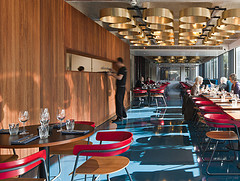 U.S. casual dining restaurant sales have grown by 8 percent between 2006 and 2011, according to a study by Mintel. Total casual dining restaurant sales are expected to reach $107.8 billion in 2011. Restaurant owners can secure a share of this competitive market through a well-designed email marketing campaign.
U.S. casual dining restaurant sales have grown by 8 percent between 2006 and 2011, according to a study by Mintel. Total casual dining restaurant sales are expected to reach $107.8 billion in 2011. Restaurant owners can secure a share of this competitive market through a well-designed email marketing campaign.
Here’s a short list of tips for restaurant owners:
1) Encourage Subscribers to Opt In
If diners have enjoyed their meal, provide them with opportunities to sign up for a regular email newsletter and special offers. Provide space for an email address in a comment card presented with their bill, offer entry into a free prize draw if they leave their business card, and have a short subscriber opt-in form prominently displayed on your website.
2) Build a Relationship with Regular Customers
Regular customers bring in steady revenue without the high costs of acquisition, making them increasingly profitable. Regular customers also provide free advertising for your restaurant through word of mouth. Rather than waiting for your name to come up in conversation, give customers something to share. By filling your emails with compelling content and including a “send to a friend” button, you can encourage your regulars to promote your establishment to their friends and family.
Be sure to acknowledge and recognize customer loyalty by segmenting your database. Segmentation prevents you sending introductory offers to long-standing customers and allows you to target your biggest spenders with your best offers.
3) Strong Offers Improve Open Rates
A 2010 study by Sign-Up revealed that emails containing strong discount offers for restaurants secured open rates of 33 percent. In contrast, weak offers led to a decline in response rate, not only for that campaign but also for future campaigns. Attractive offers encourage recipients to share with friends, widening the reach of your campaign.
4) Value Content
Send a regular newsletter to subscribers crammed full of valuable content. Include “secret” recipes, new menu items, upcoming events, and introductions to your kitchen and waiting teams. When you receive a good review, reproduce it in your newsletter.
5) Track Opens and Clicks
Track the links that attract the biggest response from recipients. By analyzing this information, you can better understand the interests of your customers. Are they more interested on clicking through to online discount vouchers or do they prefer to read up on recipe suggestions? Once you know what interests your customers most, you can tailor your email content to suit.
In the last few years, many restaurants preferred to focus their online marketing activies on social media and social networks like Facebook and Twitter. Actually email marketing still remain a powerful way to connect with customers. Email is not dead!
Main image courtesy of Restaurant & Bar Awards